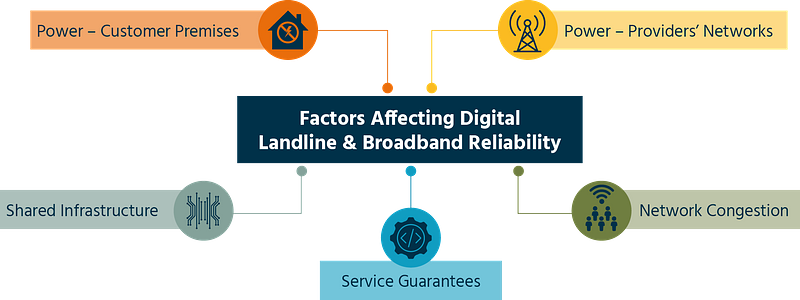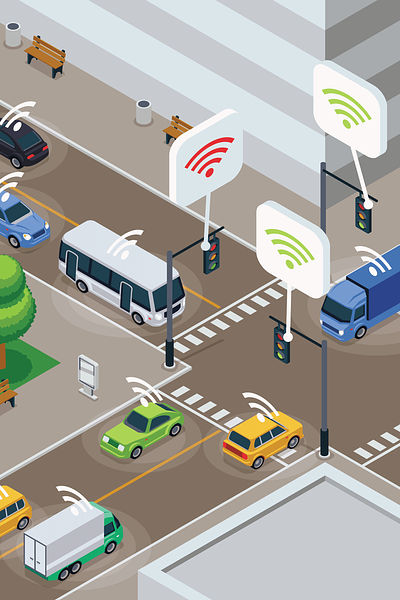Authors: Richard Parkinson, Director, and Emma Philpott, Principal Consultant & Head of Mobile & Satellite

What are the changes happening in the UK?
The UK’s fixed and mobile telephone networks are undergoing a period of significant change. This process has already started - many landlines have already been moved to digital technology, 3G mobile networks are being decommissioned, and 4G and 5G coverage is improving due to investment programmes, such as the (this will open in a new window)Shared Rural Network (SRN).
Telephony changes will continue for many years, with the landline switchover running until early 2027 and programmes to roll out full fibre broadband, close telephone exchanges, and switch off the 2G mobile network likely to run to at least the late 2020s.
FarrPoint has published a handy guide providing and timeline and more detail on the changes:
Download guide
These connectivity changes mean that many applications and services that previously relied on analogue landlines are moving to alternative connectivity. Predominantly they are moving to mobile networks as this can often be the simplest approach to implement. However, fixed broadband, IoT networks, and other wireless technologies are also being used for some applications.
How do the changes impact various digital services?
The move to digital technology prompted by these connectivity changes provides the opportunity to transform a range of services and applications, taking full advantage of the additional functionality and capabilities high bandwidth digital connectivity can support.
Correctly implemented, digital connectivity is highly resilient and reliable, however; no connectivity is 100% reliable. It is important to understand the connectivity infrastructure you rely on, the circumstances that could cause interruptions, and the impact this could have on your digital services. This allows you to understand any connectivity related risks and to implement appropriate controls to address them.
What factors should be considered?

-
Power – Customer Premises: Unlike analogue (PSTN) telephone lines which were powered from the telephone exchange, digital landlines will not operate in the event of a mains power failure. Batteries can be used to provide some protection to equipment such as routers, however, these are only likely to be useful for relatively short power outages.
-
Power – Providers’ Networks: In addition to this reliance on power in the customer premises, power outages can also impact the communication providers’ infrastructure. Digital landlines and broadband services can rely on power being available in green street cabinets – typically these will have battery backup that lasts around 4 hours in the event of a power outage. Mobile networks also rely on power backup at mast sites and in the core network to maintain services in the event of a mains failure. The amount of backup provided at mast sites varies by mobile operator and location, but in most cases is limited to a couple of hours uptime. (this will open in a new window)Ofcom recently ran a consultation on the resilience of the UK’s communication networks. This set out proposed updates to guidance on resilience for fixed networks, which included a requirement for 4-hour power backup in cabinets. The consultation also sought views on the potential for improved power backup at mobile mast sites, noting challenges such as the estimated £0.9bn – £1.8bn cost of providing 1 hour battery backup at all mast sites in the UK. Work is still ongoing by Ofcom to determine what additional resilience measures are needed within our mobile networks. However, many other countries have now recognised the critical nature of mobile networks, including Norway, Sweden, and Finland, who have all introduced requirements for up to 6 hours power backup at rural mast sites.
-
Shared Infrastructure: Shared infrastructure between communication providers can introduce single points of failure. The rollout of fibre networks means that, in many areas, connectivity infrastructure is available from multiple network providers. However, network sharing and use of wholesale services is standard practice, meaning several communication providers may be reliant on the same underlying infrastructure. Mobile network infrastructure can also be shared, and this is only likely to increase given the greater use of mast sharing agreements within the industry, the drive by mobile network operators to save costs and future potential mobile network operator mergers.
-
Service Guarantees: Digital connectivity may offer lower levels of service guarantee than was available from the services they replace. Standard broadband connectivity may come with relatively long fixed timescales, typically 1 or 2 business days, as standard. Mobile networks may offer very limited, if any, guarantee of fix times in the event of localised connectivity issues such as power failure at a mast site. These lower service guarantees could extend the duration of any service interruptions experienced.
-
Network Congestion: Congestion can impact both wired and wireless networks where there is more traffic on the network than there is available capacity. Peaks in internet traffic can slow or interrupt services, with digital services that require higher bandwidths or that are time sensitive most likely to be impacted and degraded. Quality of mobile network service can be impacted if a large number of users are trying to access the same mast, an issue most often seen in the vicinity of sports stadia, concert venues, or other large public events, or in remoter locations where backhaul from mobile masts can have a limited capacity.
How to ensure digital services obtain reliable connectivity?
Highly reliant connectivity can be provided for any service, though costs typically increase in line with reliability guarantees. To achieve the optimum balance of cost and reliability, it is usually best to start by establishing the level of reliability a service requires and then determining the connectivity solution capable of delivering it.
A combination of technical, contractual, and operational arrangements is likely to need to be put in place.
Technical arrangements will determine the connectivity solution that can deliver the required level of service and reliability. This could use multiple connectivity providers or technologies, avoiding single points of failure in the local and core network infrastructure.
Contractual arrangements ensure that communication providers resolve any service interruption or degradation within agreed timescales and provide regular reporting on service reliability.
Operational arrangements should ensure that the organisations delivering digital services know how to respond to connectivity issues. This includes knowing how to identify when a connectivity issue is impacting services, and how to report the issue. Business Continuity plans need to address the risk of connectivity related issues, and how they are responded to.
How FarrPoint can help
FarrPoint is an independent digital connectivity consultancy. We support the design of national and regional connectivity, and help organisations design and implement digital services that use this connectivity.
We help organisations:
- Understand how connectivity changes will impact their digital services
- Help establish network resilience plans and strategies
- Develop connectivity solutions that support and transform their digital services
- Develop the contractual, procurement and operational arrangements required to underpin connectivity
get in touch


